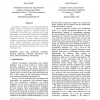Free Online Productivity Tools
i2Speak
i2Symbol
i2OCR
iTex2Img
iWeb2Print
iWeb2Shot
i2Type
iPdf2Split
iPdf2Merge
i2Bopomofo
i2Arabic
i2Style
i2Image
i2PDF
iLatex2Rtf
Sci2ools
WICSA
2007
2007
A Comparison of Static Architecture Compliance Checking Approaches
The software architecture is one of the most important artifacts created in the lifecycle of a software system. It enables, facilitates, hampers, or interferes directly the achievement of business goals, functional and quality requirements. One instrument to determine how adequate the architecture is for its intended usage is architecture compliance checking. This paper compares three static architecture compliance checking approaches (reflexion models, relation conformance rules, and component access rules) by assessing their applicability in 13 distinct dimensions. The results give guidance on when to use which approach.
Architecture Compliance | Software Architecture | Static Architecture Compliance | WICSA 2007 | WICSA 2008 |
| Added | 07 Nov 2010 |
| Updated | 07 Nov 2010 |
| Type | Conference |
| Year | 2007 |
| Where | WICSA |
| Authors | Jens Knodel, Daniel Popescu |
Comments (0)

